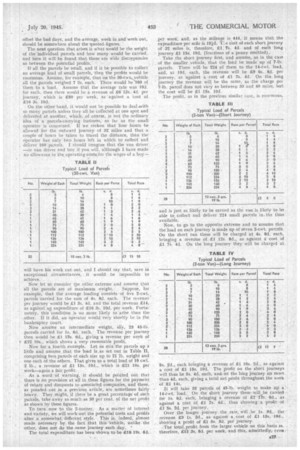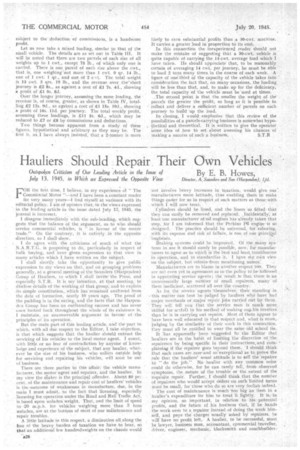Solving the Problems of the Carrier
Page 36

Page 37

Page 38

If you've noticed an error in this article please click here to report it so we can fix it.
Profits from Parcels Carrying
Showing How an Intending Parcels Carrier Should Set About Trying to Determine the Potential Profits of the Business He Has in Mind A'the conclusion ofthe previous article on this subject I gave the, .operating costs of two vehicles running over prescribed routes and engaged in the carriage of " smalls." one of these 'vehicles was of 30-cwt. capacity, covering six tithes per w,eek a route 32 miles long, so that the weekly mileage was 384. I demonstrated that the vehicle operating costs comprised standing charges £6 55. per week and running costs £7 8s. 10d., a total of £13 13s. 10d. per week. To that total must be added provision for establishment costs, and these, in a parcels-carrying business, are particularly high. It would not be safe' to estimate on less than £2 10s, per week, bringing the total expenditure on this vehicl to £16 35. 10d. per week.
The other vehicle, a 2-boner, covers this same route 'three times per week as well as a journey of 42 miles longer each way three times per week, so that its total weekly mileage is 444. I showed that the vehicle operating costs, comprising standing charges at £6 10s. and running costs at £9 9s. 6d., totalled £15 19s. 6d., to which must be added establishnie.nt costs at £3 per Aveek, making gts lOs. 6d.
Making a Ilroftt
Table I gives a hypothetical schedule of rates for parcels. What the haulier wants to know is to what extent he is likely to be able to make a profit with these two vehicles, basing his calculations on parcels carried at the rates set out in that schedule.
The first question that has to be decided is what is likely to be the average loading of the vehicles on each journey: For purposes of a calculation such as this, it may be taken that the average loading is one-third of the maximum capacity. By that I mean that the 30-.cwt. vehicle carries an average load of 10 cwt. on each journey and the. 24onner a'n average load of, say, 14 cwt. an each journey. That may mean that on some days the vehicle may set out on its journey
loaded nearly to capacity. ..
Many of the deliveries, however may be made within a short distance of the starting point, so that the van is practically empty for the latter part of the journey. That would probably be the Most profitable type of journey, because the rate for a given weight does not inctease in proportion to the distance which the parcel is carried.
On other days, the vehicle may have nearly a full load for practically the whole distance, but on others it may go empty away from the starting-point and, perhaps, pick up a few. parcels.. The good days• must be reckoned to
offset the bad days, and the average, week in and 'week out, should be somewhere about the quoted. figures.
The next question that arises is what would be' the weight of the individual parcels and how many would be carried, and here it will be found that there are wide discrepancie.s as between the potential profits. .
If all the parcels be small, and if it be possible to collect an average load Of small parcels, then the profits would be enormous. Assume, for example, that oa the 30-cwt,evehicle all the parcels weighed 7 lb. each. There would be '160 of them to a load. Assume that the average rate was 10d. for each, then there would be a revenue of £6 13s. 4d. per journey, which is £80 per week, as -against a cost of £16 3s. 10d.
On the other hand, it would not be possible to deal .with so many parcels unless they all be collected at one spot and delivered at another, which, of course, is not theordinary idea of a parcels-carrying business, so far as the small operator is concerned. If we reckon that four hours be allowed for the outward journey of 32 miles and that a couple of hours be taken to travel the distance, then the operator has only two hours left in which to collect and deliver 160 pareels. I should imagine that the van driver -or van driver and boy if you will, although I. have made no allowance in the operating costs for the wages of a boy will have his work cut out, and I should say that, save in exceptional circumstances, it would be impossible to achieve.
Now let us consider tlie other extreme and assume that
all the parcels are of maximum weight.Suppose, for example, that the average loading consists of five 2-cwt. parcels carried for the sum of 45. 8d. each. The revenue per journey would be £1 3s. 4d. and the total revenue £14. as against an expenditure of £16 as. 10d. per week. Fortunately, this condition is no more likely to arise than the other. If it did, an operator would very shortly be in the bankruptcy court.
Now assume an intermediate weight, say, 25 45.1b. parcels carried for ls. 6d. each, The revenue per journey then would be 21 1'7s. 6d., giving a revenue Per week of 422 10s., which shows a very reasonable profit.
Now for a fourth example. Let us mix the parcels up a little and assume that the load is,as set out in Table II, comprising two, parcels of each size up to 21 lb. weight and one each gf the others. That gives us a total load of 10 cwt. 2 lb., a revenue of £1 15s. 10d., which is £21 10s. per week-again a fair profit..
As a word of warning, it should be pointed out that there is no provision at all in these figures for the payment of rebate and discounts to associated companies, and these, as pointedout in A previous article,. are sometimes fairly • heavy. They. might, if there be a great percentage of such parcels, take away as much as 30 per cent, of the net profitas
shown by these figures.
To turn. now to the 2-tonner. As a matter of interest and variety, we will workout.the potential costs and profit's after a somewhat different style. This is, indeed, almost made necessary by the fact that this 'Vehicle, Unlike the other, does not do the -same journey each day,
• The total expenditure has been-shown-to -be £18 I9s.6d.
.pet week, and, as the mileage is 444, it means that the expenditure per mile is 101d. T:.e cost of each short journey of 32 miles is, therefore, £12 7s. 4d. and of each long journey £1 15s. 10d. (fractions of a penny omitted).
Take the short journey first, and assume, as in the case of the smaller vehicle, that the load be made up of 7-1b. parcels. There will be 224 of them to the 14-cwt. load, and, at 10d. each, the revenue will be £9 Os. 8d. per journey, as against a cost of 21 7s. 4d. On the long journey the revenue will be the same, as the charge per 7-1b. parcel does not vary as between 30 and 40 miles, but the cost will be RI 15s. 10d.
The profit, as in the previous similar case, is enormous, and is ust as likely to be earned as the van is likely to be able to collect and deliver 224 small parcels in.the time availab e.
Now, to go to the opposite extreme and to assume that the load on each journey is made up of seven 2-cwt, parcels. On the short run these will be charged at 4s. 8d. each, bringing a revenne Of RI 12s. $d., as against acost of £1 7s. 4d. On the long journey they will be charged at
$s. 2d., each bringing a revenue of 16s. 2d., as-against
a cost of £1 15s. 10ed. The Profit on the' short journeys will thus be 5s. 4d. each, andon the long journey no more -than 4d. each, giving a total net profit throughout the week of 21 14s.
If will .take 35 parcels of 45-lb. weight to make up a' 14-cwt. load:. On the short journey these ivillebe carriedfor Is. 6d. each, bringing a revenue of £2 I2s. 6d., a3 against a cost of £1 7s. 4d., thus showing • a profit of £1.5s. 2. per journey. . • Over the longer . journey. the, rate, will be Is. 9d., the revenue 23 Is. 3d., as against a cost of £1 15s. 101., showing a profit of £15s. 5d. per journey. ,The total, profit. from the -larger vehicle on this basis is. . therefore. £15 3s. 6d. per week, and this, admittedly, even: subject to the' deduction.of commissions, is a handsome profit.
Let us now take a mixed loading, .similar to that of the small vehicle. The details are as set out in Table III., It will hie noted that there are two parcels of each size of all weights up to 1 cwt, except 75 lb., of which only one is carried. There is one parcel cd each size above the cwt., that is, one weighinenot more than I cwt. 0 qr. 14 lb., one of I cwt. 1 qr., and one of 2 cwt. The total weight is 13 cwt: 3 qrs. 19 lb., and the revenue over the--short Journey is 22 Sc., as against a cost of 21 7s. 4d., showing a profit of 21 Os. 8d,
Over the longer joarney, assuming the same loading, the revenue is, of course, greater, as shown in •Table IV, total. ling 22 I2s. 9d., as against a cost of 21 15s. 10d., showing a profit of 16s. lid, per journey; The total weekly profit, assuming these loadings, is 2.11 Ss. 6d., which may be reduced to 27 or 28 by commissions and deductions.
Two things become apparent from a study of these figures. hypothetical and arbitrary as they may be. The first is, as.I have always insisted, that a 2-tormer is more likely to earn substantial profits than ,a 3O-Cwt. machine. It carries a greater load in proportion tb its cost,
In this connection the inexperienced reader should not make the mistake of suggesting that a 30-cwt. vehicle is quite eapahle of carrying the 14evirt, average load which I have taken. Ile Should appreciate that, to be reasonably . certain of averaging 14 cwt. per journey, lie must he able to load 2 tons many times in the course of -each week. A figure of onelthird of the capacity of the vehicle takes into consideration the fact that, on many occasions, the loading Will be less than that, and, to make up for the deficiency, the total capacity of the vehicle must be-used at times.
The second point is that the smaller the weight of the parcels the greater the prhfit, so long as it is possible to collect. and deliver a sufficient number of parcels 011 each journey to build 'up the load.
In closing, I would emphasize that this review of the possibilities of a parcele-eauying business is somewhat hypotsheticai and theoretical. It is written to 'give the operator . some idea of how to set about assessing his chances of
making a success of such a business. , S.T.R




























































